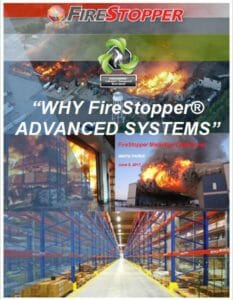This paper explains how FireStopper® Advanced Fire Fixed Systems can keep personnel and property safe from fire and explosion. Equally important to the Advanced Fire Fixed Systems is the agent used in the system. Consequently FireStopper is the best firefighting agent. In fact FireStopper is the only agent that will extinguish any fire. Markedly FireStopper extinguishes classes A to K. To summarize most fixed systems do not extinguish the fire. Advanced Fire Fixed Systems suppress the fire until the fire department arrives. Henceforth FireStopper first knocks down the heat. Then it quickly knocks out the fire! Resulting in keeping personnel and property safe from fire and explosion.
FireStopper®Fixed Systems Preface
FireStopper International Limited, a transnational Registered Company, is the developer of the most advanced and powerful firefighting and anti-explosion technology in the “World”. It devoted the first 25-years of its existence to R&D and the recipient of subsequent stand-alone testing results in ratings and certifications by the most recognized and respected third-party testing and listing facilities in the world.
Moreover, Advanced Fire Fixed Systems’ unique Technology has rendered the only available all fire class effective and anti- explosive products, which are non-toxic, non-irritant, environmentally safe and non-hazardous per the most demanding environmental and life exposure testing over all other existing and available products in the explosion, fire and safety channel of business.
In the explosion amelioration technology channel, FireStopper® branded anti explosion systems exclusively deploy EXP FFC. This FireStopper® FFC (Fire Fighting Catalyst) is an environmentally safe liquid formula (embodying all the safety characteristics of this unique technology) that has garnered the great distinction of being the only product in over 20-years of search for a product capable of suppressing hydrogen/methane explosive environment. This breakthrough discovery became apparent during its initial demonstrative testing at Gexcon, AS Norway.
Having proven the former statement through the outstanding results of the products testing, rating, and certifications thus received, FireStopper®, in tandem with its novel firefighting and anti- explosion products (the “software”), developed the most durable and reliable supporting hardware and detection systems available today, which also meet and exceed the relative standards used to certify said product lines.
With the advent of this technological breakthrough, FireStopper® can now provide Government, Industry, and by way of innovation, the consumer with a never wider dimension of safety and protection.
Notwithstanding the above, the FireStopper® lines of products reach across the full spectrum of safety application including environmental remediation post spills both onshore and offshore.
This company believes that in its capacity as a innovative manufacturer, that it must deliver equally performing hardware with reliability and durability to complement such a major, stand alone, breakthrough in fire and explosion protection. Therefore, this paper devotes its content to presenting a level playing approach for best informing you the consumer/end user of FireStopper® branded products.
In the International arena, the FireStopper® brand is the recipient of the highest certifications in all categories of Governmental requirements to market such as defined below:
Anti-Explosion
Initial stage testing – Gexcon, AS (Norway)
Handheld Portable Extinguishers:
ANSI/UL711, ULC – Southwest Research Institute (San Antonio, TX)
Defense Logistics Agency (DLA) US Gov. NSN Approval #s’ EN3-7; EN3-81 – MPA, Dresden (Germany)
CE2 – DNV
Firefighting Foam Concentrates:
EN1568 – MPA Dresden ICAO – CNPP (France)
IMO – MPA Dresden, Lloyds Registry, DNV, MED CE
Environmental Testing:
NAMSA, USA
Associated Laboratories, CA USA Environmental Medicine, Inc., USA OPUS, Ltd., UK
1 This Standard refers to hardware durability, reliability, and efficacy
2 This Mark assures manufacturing quality through yearly inspections
Executive Summary
Every new technology has barriers erected by the competition and industry supported organizations limiting access to the market. Often these barriers are based on myth or inaccurate facts that have been presented in the media. Sometimes the barriers are based on real world experience of customers using similar technologies. Other times a truly new technology comes along that addresses a problem in a different way. In all cases, it is incumbent upon the vendor to educate the marketplace, provide factually supported analysis and provide the media the opportunity to view the technology/products educating it on the new approach to solving the problem safety and environmental problems applicable to all.
The public, Government, industries such as Oil refineries, petrochemical processing plants mining operations, among many industries operate in the presence of combustible gases and vapors the precursors of explosion and fire events.
The objective of this document is to introduce and describe the now available, fully automated, and redundant manually activated FireStopper® anti explosive and fire suppression systems. This document does not cover barriers placed in safe areas but focuses only on devices placed in hazardous areas to diminish the devastating effects of explosion and fire.
FireStopper® Fixed Systems Background
“Fire is the leading cause of commercial property damage,” noted Ronnie Gibson, vice president and chief engineer with FM Global”.
“According to the NFPA’s latest information year (2015) there were 113,500 non-residential fires in the U.S. at the cost of 3.1 billion dollars”
Notwithstanding, at present the likelihood of total loss due to fire is evident by the high insurance premiums businesses are confronted with. Risk analysis by the insurance industry have elevated the costs of insuring year to year with no end in sight.
The one component of any commercial enterprise, which can never be replaced or receive adequate compensation, is for the loss of time. Additionally, if a fire were to occur in a warehouse and if the event were to be controlled or even extinguished through the deployment of an automated or hand activated system, it is certain that that the collateral damage by water or foam would far exceed the actual value of the product(s) being warehoused.
All fixed systems currently employed in warehousing, aviation hangars, transport applications and others operate on the premise that once activated, the system will run continuously until such time as it is turned off by the fire department or the individual charged with said task.
FM Global claims that a new in-rack sprinkler design option for warehouses can minimize clients’ costs as well as their risk. Apparently, this statement is born out of controlled testing results extrapolated to resemble real-life events; not very reliable…there is no way of predetermining how any fire will behave under undetermined conditions.
It is our belief that currently all fixed systems designed for fire protection operate under the same principal of application until someone determines the event to be over. All fixed systems are mechanical devises composed of piping, nozzles, detectors, and control box, activated automatically or by hand (if someone is present). The only difference in efficacy comes from the product the system is designed to deploy.
Moreover, a fire event most likely will be born out of a variety of flammable materials. As a result, massive amounts of water, foam and or combinations including the very hazardous dry chemicals.
| Fig. 13 | Fig. 2 | ||
 |  |
- Figures 1 & 2 depict the predictable consequence of activation of the currently deployed foam deluge systems
Fig. 3 Lithium Battery Fire4 Fig. 4 (Small Plane Hangar)
 |  |
Fig. 55 Fig. 6
 |  |
Fig. 7 Fig. 86
 |  |
- Fig. 3 depict the violent and explosive fire event that lithium or any other flammable metal produce. This is an actual photo of the blaze created by a lithium battery fire at a hangar.
- Figures 5, 6 & 7 are examples of actual fires that employed fire protection systems providing mostly water as the extinguishing media
- Fig. 8 depicts the massive amount of AFFF foam production required to fill the intended room (hangar) in order to deliver the minimal protection, it provides. (Please note, based on recent Government findings, AFFF is deemed a major polluter of the environment and factually, the foam technology is highly corrosive)
6 Why FireStopper®
The specialized designed to fit for purpose systems combine all stainless-steel construction for durability and reliability with the most advanced detection, control & activation support mechanism. However, what separates the FireStopper® Systems™ from all others is the Environmentally Safe (“Green”), All Flammable Materials Effective, All Fire Class, Anti-Explosive and All Temperature environment usable media. FireStopper® PFE-FR FFC & EXP FFC are only available exclusively through FireStopper® branded portables and fixed systems.
Military & Civilian Vehicles Systems Array
2.
4.
4.
5. The engine compartment fire protection system is designed primarily to detect accidental slow growth fires. Such as fuel leaks and overheating conditions. An engine fire protection system that responds in several seconds will prevent catastrophic destruction of vehicles.
 |  |
6. This system is an automatic fire/fuel explosion detection and suppression system, specifically designed for Combat Vehicles, providing increased survivability against fires initiated by IED’s (Improvised Explosive Device) and penetrating munitions. In the troop compartment, the system protects personnel by reducing pressure build-up resulting from fuel
 |  |
7. The all-wheel protection system is designed to protect the wheels and tires from fires developed by many unforeseen events including intentional and or mechanical cause by flammable fuels, hydraulics, or any other incendiary.
 | 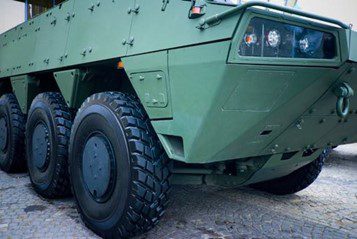 | ||
8. The Advanced Fire Fixed Systems exterior protection m is designed to extinguish fire around the egress openings of the vehicles and to enable safe evacuation or rescue of personnel. In addition, the Advanced Fire Fixed System can and will be modifiable to cover and protect the outer structure of the intended vehicle able to extinguish fires born out flammable fuels or any other fire vulnerability as the end user may require.
 |  | ||
Combined Double Shot Combat System Layout
9.
10.  |
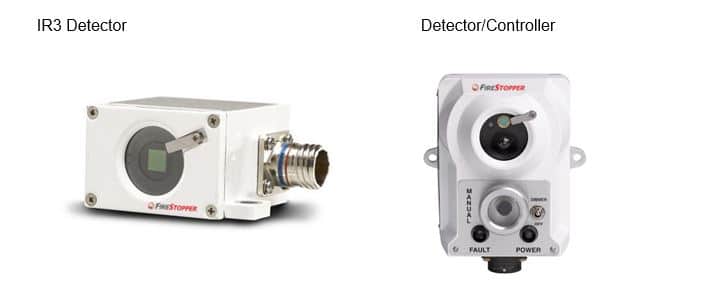 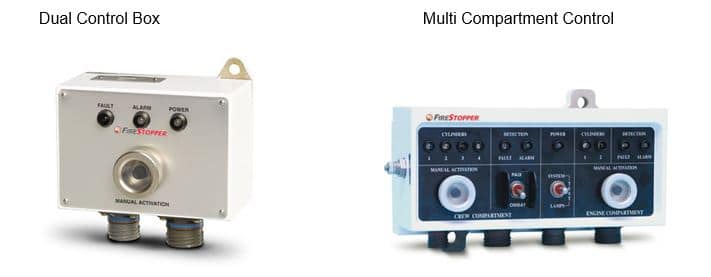 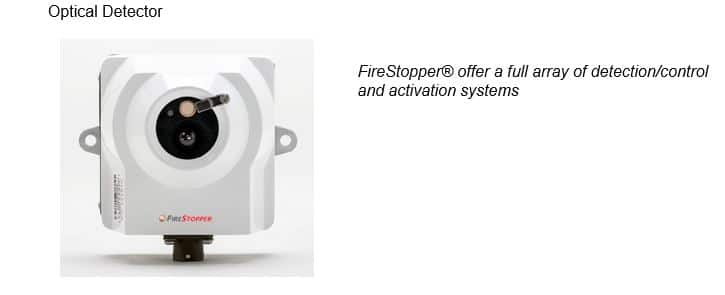 |
12. Exemplar of an amour personnel carrier’s potential system
 |
REVIEW OF REQUIREMENTS FOR AFES CREW BAY PROTECTION SYSTEMS
The crew-bay AFES used in legacy vehicles to protect the crew use high-speed extinguishers charged with Halon 1301 (bromotrifluoromethane). The performance requirements for these systems were that they quickly extinguish a fuel explosion, typically in less than 250 ms. The first systems were designed to achieve 6 to 7% Halon 1301 concentration by volume in air and to meet NFPA 12A (1970) exposure limits. Much later, the EPA invented the No Observed Adverse Effects Limit (NOAEL) and the US Army Surgeon General specified a 6% maximum.
The results of medical research of combat related issues in armored vehicles were published in the late 1980’s. The Walter Reed Army Institute did extensive research into the health aspects of Halon systems and recommended limits on criteria other than fire out time. A result was the refinement of performance and safety requirements for crew-bay AFES.
Associated with the Army’s push to develop a new crew-safe fire-suppression agent was new safety, test methodology, instrumentation, and approval issues. In addition to obtaining SNAP listing, the new agent needed to be approved by US Army Center for Health Promotion and Preventive Medicine (USACHPPM). Existing criteria for impulse force and discharge noise studies had to be revisited, and new areas of concern, such as soft tissue damage due to exposure to cryogenic fluid and dust bombardment had to be addressed. Medical criteria for the latter may need to be developed for military applications. Finally, high-speed concentration measurement instrumentation needed to be changed to accommodate agent property differences.
The new performance requirements were mainly based on reports to the US Army Surgeon General from the medical community. Maximum HFC227-BC fire suppression agent exposure concentrations were based on NFPA-2001 (2000). The acceptable acid gas levels can be based on exposure times or a peak recorded level.
The US Army develops the application-specific Fire Suppression requirement during the Performance Verification Tests.
Employing the vast advancements in the FireStopper®/Enviro-Safe® Technology today we can
demonstrate improved explosion and fire suppression in less than 50 MS in addition to providing fire protection in all known class and subclass of rated potential fires by employing advanced detection, activation, and deployment of the fail-safe suppression product, FireStopper® PFE-FR FFC and FireStopper® EXP FFC the latest development in the Technology.
These exclusive new Agents available only through FireStopper® Systems come with third-party Non-Toxic, Non-Irritant to skin and eyes certification and exceed recognized eco safety requirements as mandated by governmental decree in addition to rating and listing under NFPA 10, ANSI/UL711, and ULCS508 in addition to resisting conductivity to 100kv as required by all the above standards for “C” rating at 24 inches with a fog spray. Moreover, adjunct to the above litany of certifications, FireStopper® PFE-FR FFC is in the process of certification to EN3-7. This new candidate for use in AFES does not require premixing for ease of use and as an aqueous base product, it resists freezing to -100˚F (-73.3˚C) without employing dangerous and hazardous antifreeze compounds.
Advanced Fire Fixed Systems Conclusion
Medical and Environmental concerns necessitated changes in armored vehicles including changes to the crew-bay AFES. A major change in the AFES was the switch from Halon 1301 to a Halon- alternate suppression agent such as a blend of HFC-227ea and sodium bicarbonate based dry chemical. However, the experience gained from the recent use of alternate suppression agents to date beg for the search and implementation of an agent that would truly raise the bar on the survivability during an explosion or fire event to the AFES.
In addition, the new agent should be capable of delivering added protecting to the crew by maintaining a habitable environment in the aftermath of an ordnance intrusion event so that the crew could mount an escape or a counterattack. Moreover, the next generation agent after its deployment should not pose any added burden to perform their duties or add any danger to the health of the crew.
Notwithstanding the above, FireStopper®’s EXP FFC and PFE-FR agents are easy to handle during the required maintenance of the system therefore reducing the need for highly trained personnel in time of need. Also, their obvious advantage over the tired old technology products currently employed both in efficacy and environmental requirements, make these products the most desirable options going forward. FireStopper® is providing this advance line of products without limitation in quantity within acceptable standard delivery time.
The integration of the Halon-alternate suppression agents in crew-bay AFES presented unique challenges. The integration of FireStopper® EXP FFC and PFE-FR FFC will usher in a new and reliable system of protecting AFES in a level of safety and efficacy not contemplated to date by TACOM or any other DoD agency charged with the task of developing new requirements.
Responsibility to provide safety is owed to the public by both Government and Industry. In current profound social and economic conditions, Government, Industry, and the consumer cannot afford the risk of loss both materially and always risk to life. FireStopper® offers the only real security against the always present danger of serious environmental degradation, catastrophic fire and or worst, explosion.

